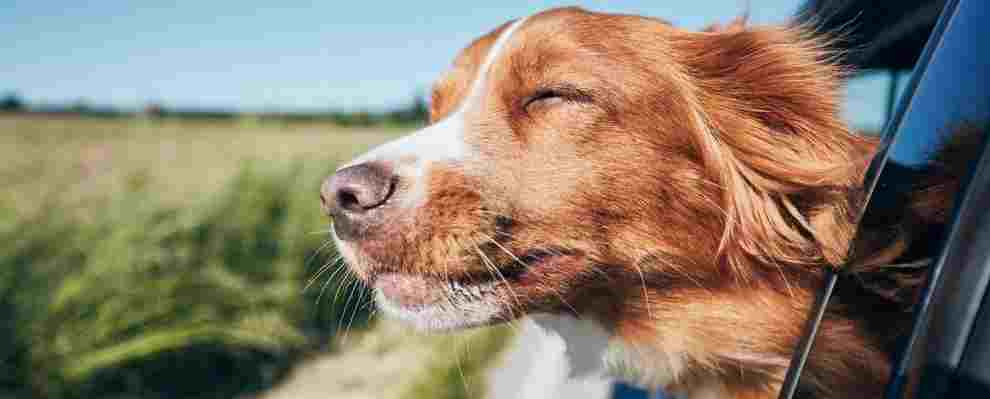Search Programs
When you click on a sponsoring school or program, or fill out a form to request information from a sponsoring school, we may earn a commission. View our advertising disclosure for more details.

A 2017 study from the University of California Los Angeles (UCLA) found that meat consumed by cats and dogs is equivalent to 64 million tons of carbon dioxide—the same amount of carbon dioxide produced by almost 14 million cars in one year. For a Toyota Prius owner who eats mostly a plant-based diet and has cats and dogs, this may seem like a huge setback in the intention to reduce one’s carbon footprint. The results from this study have eco-conscious pet owners wondering: is it possible to provide for my pet’s needs and be environmentally-friendly?
In response to this sustainability dilemma, many pet owners have inquired whether cats and dogs would benefit from a vegetarian or vegan diet. While shifting to a more plant-based diet is supported by physicians for numerous human health and environmental reasons, veterinarians urge cat and dog owners to not do the same for their pets.
The American Society for the Prevention of Cruelty to Animals (ASPCA) states that while it’s challenging at best to feed a dog a nutritionally-balanced plant-based diet, cats are obligate carnivores, meaning they need meat to survive. Taurine, an essential amino acid for cats, can only be found in animal-based protein sources and cats don’t digest nor derive nutritional benefits from carbohydrates.
Additionally, a 2015 study of commercial vegetarian pet food formulated for dogs and cats concluded that 13 dry and 11 canned pet foods were nutritionally inadequate and not in compliance with the Association of American Feed Control Officials (AAFCO) regulations. While going meat-free or exploring flexitarianism is highly recommended for human health, the same practices are nutritionally harmful and not recommended for canine and feline companions.
Just as there’s no silver bullet solution to be an environmentally-conscious person, no singular simple solution exists to help pet owners decide what is sustainable and nutritious for their cats and dogs. Author of the UCLA study Dr. Gregory Okin says, “I like dogs and cats, and I’m definitely not recommending that people get rid of their pets or put them on a vegetarian diet, which would be unhealthy,” Okin said. “But I do think we should consider all the impacts that pets have so we can have an honest conversation about them.”
In the face of uncomfortable information, it’s important to remember that awareness is the first step. Through learning more and taking small actions regularly over time, sustainable pet ownership is possible.
Read on to learn more about the impacts of pet ownership, how pet owners can reduce their carbon footprint (and pawprints), challenges and opportunities in carbon-neutral pet ownership, and sustainable pet products and practices.
How Pet Ownership Impacts the Environment
How exactly does pet ownership impact the environment?
Simply put, livestock is responsible for approximately one-fifth of global greenhouse gas emissions. Raising livestock requires immense amounts of land, food, and water. Through grazing and pooping, an overabundance of livestock creates nutrient-barren land and raises soil nutrient levels to unbalanced levels. Also, the belches and flatulence from cattle are a known producer of methane gas.
Here are some fast facts from the UCLA study showing how pet food is tied to greenhouse gas production:
- Cats and dogs contribute 25 to 30 percent of the total environmental impact created by meat consumption in the United States
- There are 163 million dogs and cats in the United States
- Cats and dogs in the US are the fifth-highest consumers of meat, behind Russia, Brazil, the United States, and China (the top four global consumers)
- Cats and dogs produce 5.1 million tons of feces annually, equivalent to what 90 million of the 321 million Americans produce
Perhaps the single most effective way humans and pets can lessen their environmental impact is by eliminating or drastically reducing their consumption of beef. According to research published in the Proceedings of the National Academy of Sciences of the United States of America (PNAS), beef has by far the largest environmental impact, requiring one order of magnitude more resources compared to other products such as dairy, poultry, pork, and eggs.
Since the USA produces the largest quantity of beef in the world, one obvious place to look at sustainable pet ownership is choosing pet food that’s not sourced from beef or beef by-products, but instead from other less impactful sources of animal protein.
How Pet Owners Can Reduce Their Pets’ Carbon Pawprint
While there are no easy solutions to solve the environmental impacts of pet ownership, Dr. Orkin mentions these two ways that pet owners can reduce their pets’ carbon pawprint when it comes to pet food.
Find Alternative Sources of Protein
As previously mentioned, growing cattle requires an enormous amount of land, food, and water compared to other forms of livestock. Consider buying pet food sourced from livestock that has a lesser environmental impact than cattle, such as poultry, waterfowl, and eggs.
Crickets are gaining in popularity as a protein-rich and environmentally friendly source of protein for humans and dogs. A variety of pet foods are available from local and online retailers, so read labels carefully to learn the ingredients.
Don’t Overfeed
Eating enough but not too much is an obvious but often overlooked solution for humans and animals to combat climate change.
In 2018, the New York Times reported that 60 percent of cats and 56 percent of dogs were at an unhealthy weight. Be sure that your pet is not receiving too much food. Dietary recommendations based on an animal’s weight are often included in commercial pet food. Talk to a veterinarian to determine the healthy weight for a pet or use the bird’s-eye-view test.
Challenges & Solutions Moving Towards Carbon-Neutral Pet Ownership
Here are three challenges and solutions in moving towards carbon-neutral pet ownership.
| Challenge | Solution |
|---|---|
|
Challenge: Premium pet foods are on the rise.
Decades ago, “pet food” was marketed using just those two words, but in recent years pet food trends have shifted to reflect human trends in food consciousness similar to what shoppers at high-end grocery stores like Whole Foods are looking for.
By the numbers, Americans increased their spending on pet food from $18 billion in 2009 to $30 billion in 2017, a rate of growth that does not correlate with a rise in pet ownership. This means the premium pet food market share is increasing substantially and leaving out other forms of meat that are safe and nutritionally adequate for pets. |
Solution: Feed your pet animal bone meal, marrow, by-product, and organ meats.
While feeding your pet high-quality food is important, human-grade meat creates a higher carbon footprint compared to meat by-products such as animal bone meal or organ meats.
Dr. Kelly Scott Swanson, a professor of animal and nutritional sciences in the College of Veterinary Medicine at the University of Illinois at Urbana–Champaign supports the nutritional and environmental benefits of these protein sources, saying, “It is a method of recycling nutrient- and energy-rich products,” ensuring that no part of a slaughtered animal goes to waste. |
|
Challenge: Pet food distribution has a big environmental impact.
Buying commercial pet food requires transporting goods from farm to factory to the food distribution supply chain. The Environmental Protection Agency (EPA) shows that 28 percent of the total greenhouse gas (GHG) emissions come from transportation and that emissions created from fossil fuels are the largest contributor to GHGs. |
Solution: Buy meat direct from a farm.
When and if possible, source meats or meat by-products locally to cut down on transportation emissions from fossil fuels. This solution has the benefit of keeping money in a local economy, given a pet owner lives near a farm that butchers livestock. |
|
Challenge: Bigger dogs make a bigger impact.
Simple math dictates that bigger dogs require more food and create a larger amount of feces waste, adding to an already burgeoning landfill crisis. While cats vary less in their size and environmental impact, bigger dogs mean a bigger environmental impact. |
Solution: Adopt smaller dogs or consider a rodent.
If you’re on the fence about whether to adopt a large-, medium-, or small-sized dog, know that adopting a smaller dog requires fewer food resources and fewer feces—a logical choice for pet owners who are concerned about the environmental impact of pet ownership.
If you’re feeling indifferent about dogs or cats but still want a pet, consider adopting an herbivore such as a hamster, gerbil, or rat. |
Sustainable Pet Products and Practices
Above all, the author of this study is not suggesting that people get rid of their pets in the name of becoming more eco-conscious. Pet owners around the world have increased metrics for mental and physical health and owning a pet is shown to increase empathy and social contact in adults and children. A study published by Oxford University Press in the American Institute of Biological Sciences asserts that sustainable pet ownership must include the current and future needs analysis to provide the most appropriate nutrition for the growing number of companion animals and calls to develop a standard referred to as the ecological paw print (EPP).
While the experts work on concluding environmentally sustainable solutions for cat and dog owners, here are some long-term sustainable pet products and practices to lessen the EPP on the planet.
Spay or Neuter Your Cat or Dog
Spaying and neutering is the number one solution to prevent the overpopulation of cats and dogs, which leads to increased EPP and worse, the euthanization of millions of cats and dogs every year. Beyond much-needed population control, the Humane Society of the United States lists numerous health and behavior benefits gained from spaying and neutering, which means a happier household and fewer mouths to feed.
Support Sustainable Pet Food
As previously mentioned, avoiding beef-based pet food will lessen the environmental impact, but what about insects? Consuming cricket protein means substantially less C02, fewer resources, and more nutrients from a more humane source.
All the Best Pet Care provides a list of sustainably-sourced commercial dog and cat food. Brands such as Wild Earth and Yora offer sustainable dog food brands striving to keep nutrition high and environmental impact low.
As well, the Tufts University Cummings Veterinary Medical School keeps a Clinical Nutrition Service blog advising consumers on how to buy cat and dog food and what foods and supplements to consider for specific medical conditions.
Please note that it’s recommended to consult a veterinarian about what’s best for your cat or dog’s diet and that prevailing veterinary wisdom around whether plant-based diets are acceptable is as follows: for dogs: maybe; for cats: no.
Dispose of Pet Waste Properly
To avoid contaminating wastewater systems, always dispose of solid pet waste in the trash. To lessen the environmental impact of plastic bags in landfills, dog owners can use biodegradable pet waste bags such as BioBags which are lined with a resin called Mater-Bi that’s derived from plants, vegetable oils, and compostable polymers.
Cat owners are urged to use naturally-sourced or recyclable cat litter made from corn, wheat, wood, or compressed newspaper. Feline Pine contains natural pine and releases less dust than conventional cat litters made from sodium bentonite, a strip-mined mineral.
Purchase Eco-Friendly Pet Toys
Finding a dog toy that’s durable and made with eco-friendly materials may seem challenging, but there are plenty of options on the market to keep your pet entertained. Treehugger.com, a modern sustainability site that offers eco-savvy advice, provides a list of dog toys made from recycled materials and built to withstand lots of slobbery and vigorous games of fetch and tug.

